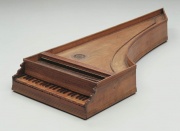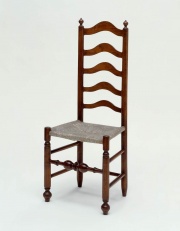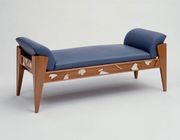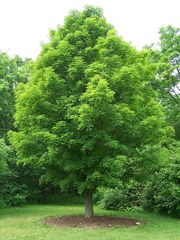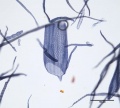Maple
Description
A commonly found deciduous tree of the genus Acer native to North America, Asia, Europe and northern Africa. Maples generally grow to 10-45m in height and are easy distinguised by their leaves that are palmate veined (3 to 9) with pointed lobed. Their distintive fruits occur in pairs with each attached to a flattened wing of fibrous papery tissu that have been called helicopters and whirlybirds. The Sugar maple (Acer saccharum) is the most commercially important tree in North America. While known for its sap, the hard, durable sugar maple wood is used for dance floors, bowling alleys, furniture, cabinetry, musical instruments, baseball bats and veneer. The sycamore maple (Acer pseudoplatanus) commonly found in Europe also produces a hard wood commonly used for furniture and musical instrument. Wood from softer maples, such as the Red maple (Acer rubrum), is used for engraving blocks, carving and paper pulp. The bark and leaves of the red maple and the amur maple (Acer ginnala) can also be used to make lightfast brown or black dyes. In general, maple wood has a fine texture with a straight grain. The medium weight wood is sufficiently durable for all purposes. Bird's eye maple and other figuring patterns are popular for decorative work.
Synonyms and Related Terms
harewood; silkwood; sugar maple (Acer saccharum); red maple (Acer rubrum); Løn-slægten (Dan.); Ahorn (Deut.); acero (It.); arce (Esp.); bordo (Port.); érable (Fr.); esdoorn (Ned.); Klon (Pol.); Lönnar (Sven.)
Chemical and Physical Properties
Light reddish brown wood. Small pores. Distinct rings. Rays show as fine dashes in quarter sawed wood. Density = 39-50 ppcf
Paper fiber type: hardwood, diffuse porous. Using transmitted light microscopy, pulp is identified by short vessels with prominent spiral thickening. Pitting on vessels is alternate. Perforations are simple. Appearance with Graff "C" stain: dark blue, but varies with bleaching. Average dimensions of fibers: length 0.7-1.1mm, 10-20μm wide. Common pulping method: kraft.
Working Properties
Hard maples produces lumber that is dense, durable, heavy, stiff and strong. It, however, dries slowly with high shrinkage. Once dried, the atttractive wood present a close, fine texture, straight grain that machines well and turns easily. The surface accepts stain easily and can be polished to an attractive finish. The hard, close grain does not carve well and sometimes is difficult to glue.
Soft maples produce a wood that is lighter in weight and coarser in grain than the hard maples. It is not as stiff but resists warping and twisting better. Their lower density allows easier glueing and staining but the surface will not produce a high polish.
Additional Images
Resources and Citations
- Alden Identification Services, Microscopic Wood Identification: Link
- Schoch, W., Heller, I., Schweingruber, F.H., Kienast, F., 2004:Wood anatomy of central European Species: Norway Maple,Acer platanoides L.
- Wood Magazine: https://www.woodmagazine.com/materials-guide/lumber/wood-species-2/maple (Accessed April 2020)
- Wikipedia: http://en.wikipedia.org/wiki/Maple (Accessed Sept. 30, 2005 and April 2020)
- R.J. Adrosko, Natural Dyes in the United States, Smithsonian Institution Press, Washington, DC, 1968
- Ralph Mayer, A Dictionary of Art Terms and Techniques, Harper and Row Publishers, New York, 1969 (also 1945 printing)
- F. H. Titmuss, Commercial Timbers of the World, The Technical Press Ltd., London, 1965 Comment: 40-50 ppcf
- Dictionary of Building Preservation, Ward Bucher, ed., John Wiley & Sons, Inc., New York City, 1996
- Encyclopedia Britannica, http://www.britannica.com Comment: "maple" [Accessed October 24, 2001].
- Edward Reich, Carlton J. Siegler, Consumer Goods: How to Know and Use Them, American Book Company, New York City, 1937
- G.S.Brady, Materials Handbook, McGraw-Hill Book Co., New York, 1971 Comment: p. 498
- Random House, Webster's Encyclopedic Unabridged Dictionary of the English Language, Grammercy Book, New York, 1997
- The American Heritage Dictionary or Encarta, via Microsoft Bookshelf 98, Microsoft Corp., 1998
- CRC Handbook of Chemistry and Physics, Robert Weast (ed.), CRC Press, Boca Raton, Florida, v. 61, 1980 Comment: density=39-47 ppcf (0.62-0.75 g/cm3)
- Marja-Sisko Ilvessalo-Pfäffli. Fiber Atlas: Identification of Papermaking Fibers (Springer Series in Wood Science). Springer, 1995.
- Walter Rantanen. "Fiber ID Course." Integrated Paper Services. June 2013. Lecture.
